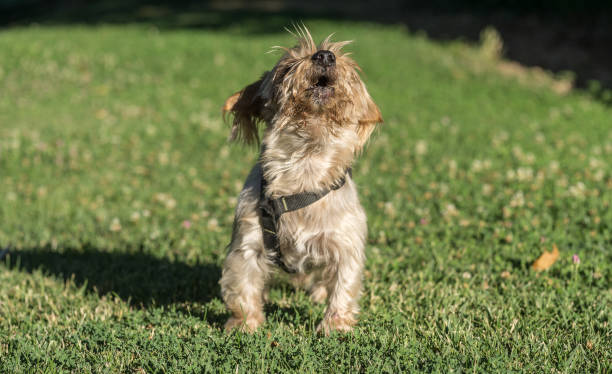Last Updated on April 12, 2024 by Dog Lover
IS DOG WHINING PAINFUL? Understanding Your Canine Companion’s Communication
Have you ever curled up on the couch with your furry best friend, only to be interrupted by a symphony of whines? Dog whining is a common behavior that can leave pet owners scratching their heads.
While a whine might seem straightforward on the surface, it can actually communicate a wide range of emotions and needs. So, the question remains: is dog whining painful?
The answer, like most things in the wonderful world of dogs, isn’t always a simple yes or no. Whining can be a sign of pain, but it can also indicate a variety of other things.
In this comprehensive guide, we’ll delve into the fascinating world of canine communication, exploring the reasons behind dog whining and how to decipher what your pup is trying to tell you.
We’ll also provide tips on how to soothe your whining dog and determine if a trip to the vet is necessary.
By the end of this article, you’ll be a whiz at understanding your furry friend’s vocalizations and ready to address their needs with confidence.
Here’s what we’ll cover:
- Understanding Dog Whining: A Language of Its Own
- Beyond Pain: Decoding the Different Types of Whines
- Body Language Matters: Putting the Whine in Context
- When Whining Becomes a Medical Concern: Signs to Watch For
- Calming the Whines: Strategies for Soothing Your Dog
- Building a Bond of Communication: Training Tips to Reduce Whining
- Beyond Whining: Exploring Other Vocalizations
- Age Matters: How Whining Changes with Puppyhood, Adulthood, and Senior Years
- Breed Predispositions: Understanding Whining Tendencies in Different Breeds
- Creating a Whine-Free Home: Long-Term Strategies for a Happy Pup

Understanding Dog Whining: A Language of Its Own
Dogs are masters of nonverbal communication. They use a combination of body language, facial expressions, and vocalizations to express themselves.
Whining is just one tool in their communication toolbox. Just like human crying can convey sadness, frustration, or pain, a dog’s whine can have a variety of meanings.
:max_bytes(150000):strip_icc()/jack-russell-yawning--oxfordshire--uk-56316163-5c421c1e46e0fb00011a36d7.jpg)
Decoding the Different Types of Whines
Not all whines are created equal. The pitch, duration, and intensity of a whine can offer clues as to what your dog is feeling.
Here’s a breakdown of some common whines and their potential meanings:
- High-Pitched Whine: This type of whine often indicates excitement, anticipation, or a plea for attention. Think of a puppy whining with joy at the sight of its leash, ready for a walk.
- Low-Pitched Whine: A low, drawn-out whine can suggest anxiety, fear, or submission. Your dog might whimper in this way during a thunderstorm or when meeting a new person.
- Whimpering: Short, repetitive whimpers can signal pain or discomfort. If your dog whines and licks a specific area, it might be injured.
Body Language Matters: Putting the Whine in Context
While the whine itself offers valuable information, it’s crucial to consider your dog’s body language for a complete picture.
Here are some signs to watch for:
- Tail Position: A wagging tail often accompanies a happy whine, while a tucked tail might indicate fear or submission.
- Facial Expressions: Pay attention to your dog’s ears and eyes. Flattened ears and wide eyes can suggest anxiety, while relaxed ears and soft eyes might signify contentment.
- Posture: A tense posture with raised hackles could indicate fear or aggression, while a relaxed, playful posture suggests excitement.
When Whining Becomes a Medical Concern: Signs to Watch For
While whining is a normal canine behavior, it’s important to be aware of signs that might indicate a medical issue. Here are some red flags:
- Constant Whining: If your dog whines excessively, regardless of the situation, it could be a sign of pain or underlying medical conditions.
- Whining Accompanied by Other Symptoms: Look for changes in appetite, lethargy, vomiting, or difficulty moving. These symptoms, combined with whining, warrant a visit to the vet.
- Whining When Touched in a Specific Area: If your dog whines and flinches when you touch a particular body part, it’s likely experiencing pain in that area.

Calming the Whines: Strategies for Soothing Your Dog
If your dog is whining, the first step is to identify the cause. Here are some tips for calming your furry friend
Address basic needs:
- Ensure your dog has access to fresh water, food, and a comfortable place to rest. A simple solution might be refilling their water bowl or offering a favorite chew toy.
- Take your dog for a potty break. Sometimes, a whining dog simply needs to relieve themselves.
- Provide comfort and affection. If your dog seems anxious or fearful, offer gentle petting, soothing words, or a cuddle session.
Building a Bond of Communication: Training Tips to Reduce Whining
While you can’t eliminate whining entirely, you can train your dog to communicate their needs in more constructive ways.
Here are some helpful tips:
- Reward desired behaviors. When your dog uses quiet cues (like sitting or making eye contact) to get your attention, praise and reward them. This reinforces positive communication methods.
- Ignore attention-seeking whines. If your dog whines for attention, resist the urge to give in. Wait for a quiet moment before offering them what they want. This teaches them that whining won’t get results.
- Provide enrichment activities. A bored dog is more likely to whine. Keep your pup mentally stimulated with chew toys, puzzle feeders, and interactive playtime.
Beyond Whining: Exploring Other Vocalizations
Whining is just one vocalization in your dog’s repertoire. Here are some other common sounds and their meanings:
- Barking: Can indicate excitement, territoriality, or an alert.
- Growling: A warning sign of fear, aggression, or pain.
- Howling: Used for communication with other dogs, expressing loneliness, or responding to sirens.
- Yelping: A sudden, sharp vocalization often indicating pain or surprise.

Age Matters: How Whining Changes with Puppyhood, Adulthood, and Senior Years
Puppies whine frequently as they communicate needs and adjust to their new environment.
Adult dogs may whine situationally, while senior dogs might whine due to age-related ailments or cognitive decline.
Understanding your dog’s life stage can help you interpret their whines.
Breed Predispositions: Understanding Whining Tendencies in Different Breeds
Some breeds are naturally more vocal than others. Herding breeds, for example, might whine to express their desire to control or herd.
Research your dog’s breed to understand their typical vocalizations.
Creating a Whine-Free Home: Long-Term Strategies for a Happy Pup
By addressing your dog’s basic needs, providing proper training, and building a strong bond, you can minimize unnecessary whining.
A happy, well-adjusted dog with clear communication channels is less likely to resort to excessive whining.
Conclusion
Understanding your dog’s whines is key to fostering a strong and happy relationship.
By paying attention to the context, body language, and other cues, you can decipher your pup’s messages and address their needs effectively.
Remember, a little patience and training can go a long way in creating a whine-free home environment.
FAQs
Should I scold my dog for whining?
Scolding will likely only worsen the behavior. Focus on identifying the cause of the whine and addressing it calmly.
How can I tell the difference between a pain whine and an attention whine?
Pain whines are often accompanied by other symptoms like lethargy, licking a specific area, or difficulty moving. Attention whines typically occur when you’re not actively engaging with your dog.
What if my dog whines at night?
Nighttime whines could indicate boredom, separation anxiety, or a medical issue. Ensure your dog has pottied before bed, provide a comfortable sleeping space, and consult your vet if the whining persists.
My dog whines when I leave the house. What can I do?
This could be separation anxiety. Work on gradual desensitization by leaving for short periods and rewarding calm behavior upon your return. Consult a trainer for more guidance.
Is there anything else I can do to prevent whining?
Regular exercise and mental stimulation are crucial for a well-balanced dog. A tired pup is less likely to whine out of boredom or frustration.
Verified Sources:
- American Society for the Prevention of Cruelty to Animals (ASPCA): https://www.aspca.org/
- American Kennel Club (AKC): https://www.akc.org/
- VCA Animal Hospitals: https://vcahospitals.com/

















